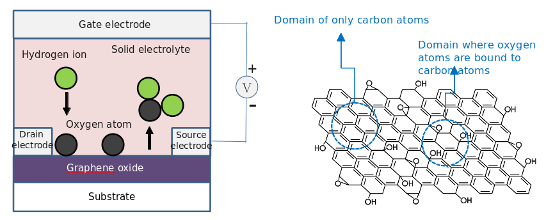In Situ Band-gap Tuning of Graphene Oxide
Open a Door to Developing High-Performance Nanoscale Devices Using New Carbon Materials
2013.12.16
(2014.01.07 Update)
National Institute for Materials Science (NIMS)
A research group of the NIMS International Center for Materials Nanoarchitectonics (MANA) succeeded in in-situ band-gap tuning which will be a key toward developing high-performance nanoscale devices using ultimately thin graphene oxide membranes.
Abstract
- A research group of the International Center for Materials Nanoarchitectonics (MANA) of the National Institute for Materials Science (NIMS; President: Sukekatsu Ushioda), led by Dr. Takashi Tsuchiya (research scientist), Dr. Kazuya Terabe (Group Leader) and Dr. Masakazu Aono (MANA Director), succeeded in in situ band-gap tuning which will be a key toward developing high-performance nanoscale devices using ultimately thin graphene oxide membranes.
- Graphene is expected to be a "post-silicon," innovative material for making next-generation nanoscale electronic devices and circuits. However, it is a carbon material which has metal conductivity but lacks a band-gap, and this nature has been an obstacle to constructing electronic devices with this material. Although creating and tuning a band-gap in situ using external voltage was proposed, this approach is volatile in that the tuned band-gap is lost when the supply of external voltage is stopped.
- The research group developed a method for creating a band-gap by changing the bonding state of carbon atoms that compose graphene through reversible absorption and desorption of oxygen atoms on the graphene, and tuning the band-gap in situ. This method enables band-gap tuning in a non-volatile manner; the tuned band-gap continues to exist even when voltage supply is stopped. In order to control absorption and desorption of oxygen atoms on the graphene, the group used solid electrolytes in which hydrogen ions can move, thereby causing electrochemical reactions between oxygen atoms, which are chemically bonded to the graphene, and hydrogen ions.
- This band-gap tuning method will be a key toward developing non-volatile switching devices and other high-performance nanoelectronics devices using graphene. It will also be available as an effective tool to search and control properties of diamond as well as new carbon materials including carbon nanotubes and fullerenes.
- The research results were published in the online version of a science journal, ADVANCED MATERIALS, as one of the Recently Published Issues, on December 16, 2013, 20:00 JST.

Figure 1 (left): A device structure for tuning the band-gap of graphene oxide
Figure 2 (right): The crystalline structure of graphene oxide, in which oxygen atoms (O) are bonded to the honeycomb graphene structure composed of carbon atoms.